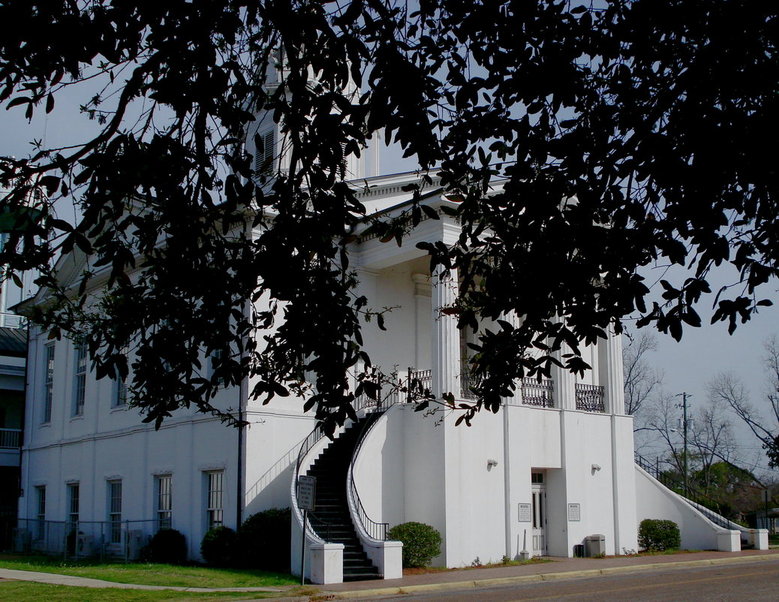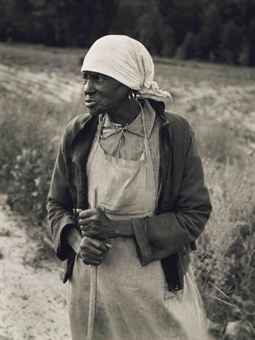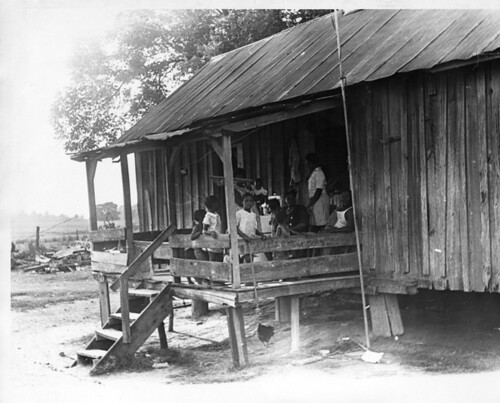
Red Dirt Road, Lowndes County, Alabama
The Lowndes County investigation
But Du Bois, still working on the premise that "truth will make us free" was tireless in his efforts for further investigations of conditions of the American black. He sought support from Carroll Wright and bombarded him with plans. Wright found particularly appealing Du Bois' proposal to study social and economic conditions of blacks in Lowndes County, Ala., in the heart of the black belt.
Wright blew hot and cold on the Lowndes County study. The following are excerpts of some of Carroll Wright's letters to W.E.B. Du Bois:
"I am not certain now whether I can take up any of the subjects which you suggest, but before deciding definitely I would like to know your idea of the first subject which you name that is, a study of conditions in Lowndes County, Alabama.32
"I think I may be able to authorize the Lowndes County study, provided I can pay for the report you make after the Month of June, 1903.33
"I do not believe it will be possible for us in the near future to take up the question of the Lowndes County Negroes. This is a financial question with us at the present time."34

After Carroll Wright retired, Commissioner of Labor Charles P. Neill alternately raised and dashed Du Bois' hopes. He telegraphed on June 26, 1905:
"Inform me of the cost of study . . . Wire reply."
Then on July 7, 1905, Neill explained:
"At the time I wired you at Atlanta, we had some funds available . . . and not being able to get in touch with you, we closed an agreement for (other) work . . . if we have anything available at the end of the present fiscal year, I will be glad to take up the matter with you at that time. . . ."
Early in February 1906 Du Bois met with Neill and must have been very persuasive, for Neill shifted somewhat from his position against more black studies, but he stated that Du Bois' would "be the only study of the Negro I would care to have made." On February 16, 1906, Neill rejected a black study by Monroe N. Work, on the grounds that he had already made "partial arrangements" for a study of black workers. On May 7, 1906, Neill wrote to Richard R. Wright, Jr., rejecting a study he had suggested because of plans to have Du Bois make a "comprehensive study" of a black community. Neill received a comprehensive outline from Du Bois and met with him in Washington in June of 1906. Then followed a series of letters in the summer of 1906 from Neill to Du Bois in which the funds for the study were promised and deadlines set.
After 5 years of frustration and delay, Du Bois began what he considered the most important survey of black Americans up to that time. Du Bois wrote in his Autobiography:

"I wanted to take Lowndes County, Alabama, in a former slave state with a large majority of Negroes, and make a social and economic study from the earliest times when documents were available, down to the present; supplemented by studies of official records and a present house-to-house canvass of Negroes.... Helped by Monroe Work.…and R. R. Wright…and a dozen or more local employees, I settled at the Calhoun School and began the study.
"It was carried on with all sorts of difficulties, including financing…and with the greeting of some of my agents with shotguns in certain parts of the county; but it was eventually finished. The difficult schedules were tabulated and I made chronological maps of the division of the land; I considered the distribution of Labor; the relation of landlord and tenant; the political organization and the family life and the distribution of the population …."35

The scope and difficulty of the study is borne out by extracts from Neill's letters to Du Bois in the fall of 1906 which reveal that 6,000 families were to be studied and 10,000 copies of the Lowndes County schedules ordered printed. In addition, one or two agents from the Bureau were to be sent to Lowndes County to examine records of mortgages, liens, and crime, and records of the justice of the peace. These agents were also to secure information from white men regarding politics and sexual morality and were to take a census of white workers. Neill appeared a bit uncertain about the use of information collected and on October 17, he wrote Du Bois:
"I am not quite sure that the schedules which you have used for a colored census will serve for the census of white laborers; if not, I would suggest that you send me a form of schedule for this purpose at once."

Recognizing the problem of resistance, Neill on November 7 wrote:
"I note what you say with reference to the difficulty of securing schedules in certain outlying districts, and if this difficulty is great and likely to arouse considerable antagonism, the canvass of families in these districts may be abandoned. Nevertheless, I trust that you will make the canvass as complete as possible."
In the same letter, he assured the author that the law division of the Bureau had begun compiling laws and court decisions for Du Bois on selected subjects, a task Neill found "very considerable."

Aside from a letter 2 weeks later telling Du Bois that he would have to have a special map made because those commercially available were inadequate, there is no further record because the method of filing correspondence was changed in a way which made it more difficult for later researchers to trace.
Du Bois, in his Autobiography, gives a skimpy version of his side of the story:
“The report was finished by hand with no copy, and rushed to Washington. I was criticized and I spent some weeks there in person, revising and perfecting it. It was finally accepted by the government, and $2,000 paid for it, most of which went back to the University. . . .
“I finally approached the Bureau and tried to find out when it would be published and was told the Bureau had decided not to publish the manuscript, since it ‘touched on political matters.’ I was astonished and disappointed, but after a year I went back to them again and asked if they would allow me to have the manuscript since they were not going to use it. They told me it had been destroyed! (Italics added.) 36
So ended the early Department of Labor black studies effort. More than a decade elapsed before the Bureau again studied conditions of black workers.

An exercise in speculation
Why, after so major an effort, was Du Bois' work destroyed? One reason may have been that the Bureau of Labor was already under attack because of its reports on child labor which some Southern Congressmen charged were "vile and slanderous upon our people." Senator Lee S. Overman of North Carolina later told his Senate colleagues that he protested to the Secretary of Commerce and Labor, Charles Nagel, who promised that some of the material would not be published.37
The problem the Bureau of Labor faced can be surmised from the experience of the Department of Justice. A U.S. attorney described a case involving J. W. Dixon, sheriff of Lowndes County, the same county Du Bois was studying. When the Grand Jury investigated an incredibly brutal case of forced labor, "five Dixon brothers rode up on their horses at 12 o'clock Saturday night" to warn one of the grand jurors "what to expect." "These Dixons," the U.S. attorney observed, "are men of the highest political and financial influence….They are large planters and control a great deal of labor....They are said to have killed several men. It is believed that witnesses are practically compelled to perjure their souls because they fear their lives…" The Dixons were not indicted.38 In the light of its own and Department of Justice experiences, Bureau of Labor officials might have doubts about publishing Du Bois' investigation of social and economic conditions in Lowndes County.

Another difficulty may have been Du Bois' growing militancy. While working in Lowndes County, he received news of the Atlanta riot of 1906 in which white mobs with police support invaded the Atlanta ghetto, killed four blacks, and wantonly destroyed black property. "I took the next train for Atlanta and my family," he wrote. A "poor Negro in Central Georgia...had been lynched, and...his knuckles were on exhibition at a grocery store." How could a scholar remain detached, Du Bois asked, when his black brothers were being starved, beaten, and lynched?39 He expressed his bitterness in his Litany of Atlanta, written on the train from Lowndes County to Atlanta:
"Doth not this justice of hell stink in Thy nostrils, O God….Sit no longer dumb, Lord God, deaf to our prayers and dumb to our dumb suffering. Surely Thou, too, are not white, O Lord, a pale, bloodless, heartless thing!"40
Du Bois' attacks against Booker T. Washington may have been a factor in the rejection of his study. Not only did many blacks consider Washington as their peerless leader, but whites also treated him as the spokesman of black aspirations. But Du Bois challenged Washington's implicit acceptance of black inferiority in return for modest economic rewards. President Theodore Roosevelt used Booker T. Washington as his power broker for Federal awards to blacks. Both Washington and Roosevelt considered Du Bois dangerous. And Booker T. Washington has been charged with using this power to throttle opponents. In an era of racial hatred, it would not have been hard to suppress an investigation of politics, living conditions, crime, landlord‑tenant relations, debt, economic peonage, miscegenation, and sexual morality in a county in the heart of the black belt.

Statistical suicide?
Du Bois blamed the Bureau of Labor and Commissioner of Labor, Charles Neill, for the destruction of his Lowndes County study. That the Bureau and its Commissioner would do such a thing seems unbelievable. After all, the foundation upon which the Bureau was built was faithful investigation and fearless reporting. The mishandling of statistics, Carroll Wright said, was a "crime" punished by the "unwritten law" which sentences the "man who prostitutes the cause of humanity."41
Although Charles Neill did not attain the stature of Carroll Wright whose place he took, he was a thoughtful scholar with a reputation for ability, integrity, and courage. He was a leader in the Catholic movements for ethical social conduct. He had backed Du Bois while he was investigating in Lowndes County. During his term as Commissioner, the Bureau investigated working conditions of women and children and industrial accidents. Neill created so many enemies because of his reports that his reconfirmation as Commissioner of Labor Statistics was twice rejected by the Senate .42
Yet as incongruous as it might seem, Du Bois was able to make a strong case in his charges against Neill. In the climate of the times, Du Bois' study may have been too hot to handle.
Scholars like to say "tell the truth and let the chips fall where they may." This is possible under conditions where reason can prevail. But sometimes when human passions are involved, people do not want their convictions challenged by fact. Such was the issue of the race relations in 1907 and 1908.
In this atmosphere Du Bois in part recanted his earlier philosophy. "I regarded it as axiomatic that the world wanted to learn the truth," he wrote. "This was of course but a young man's idealism, not by any means false, but also never universally true." Without abandoning scholarship, Du Bois, in addition, became a propagandist for black social equality.

Neill also, like Du Bois, believed in the search for truth. But did he also have his limits? Did he consider the problems of publishing Du Bois' report tantamount to statistical suicide for the Bureau? Did Neill think he could surrender on one front and still continue objective research in other areas? The fact remains that the Bureau's failure to publish Du Bois' report or to return the data to him, led Du Bois to point an accusing finger at Neill. In his Autobiography, Du Bois wrote:
"The successors of Carroll Wright deliberately destroyed this piece of my best sociological work." (source: USA Department of Labor)

No comments:
Post a Comment